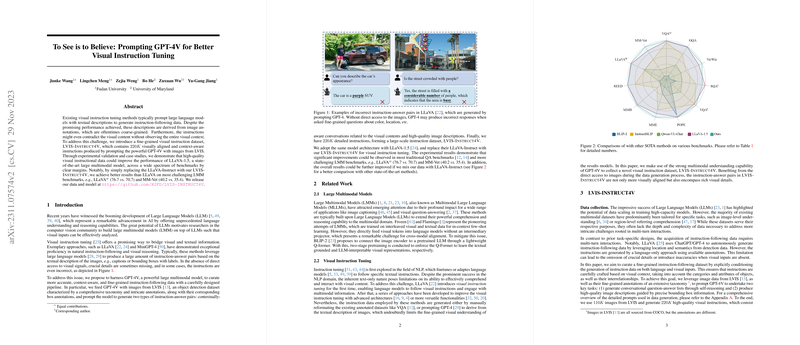An Overview of "To See is to Believe: Prompting GPT-4V for Better Visual Instruction Tuning"
The paper "To See is to Believe: Prompting GPT-4V for Better Visual Instruction Tuning" investigates advancements in visual instruction tuning by leveraging the capabilities of GPT-4V, a large multimodal model. The paper addresses the limitations of current visual instruction tuning methods that predominantly rely on textual descriptions derived from coarse-grained image annotations. These methods often lack the nuanced understanding required in visual context alignment, leading to contradictions in instructions relative to visual content.
The authors propose the LVIS-Instruct4V dataset, comprising 220,000 visually fine-grained and context-aware instruction data entries. This dataset leverages GPT-4V for generating instruction-answer pairs by incorporating images directly into the prompting process. By drawing from the LVIS object detection dataset, known for detailed annotations and extensive taxonomy, the paper facilitates a more accurate and contextually rich set of instructions.
Key Contributions and Methodology
- Dataset Construction: The paper introduces LVIS-Instruct4V, cultivated using GPT-4V guided by visually contextualized prompts. This collection encompasses 220K instructions, marked by detailed object annotations, enabling finer attention to visual nuances like object positioning, counting, attributes, and interactions.
- Architectural Framework: The research employs LLaVA-1.5, a leading large multimodal model, and replaces previous data with the LVIS-Instruct4V dataset. Such an alignment is posited to bridge the gap between visual and textual information more efficiently.
- Experimental Outcomes: The incorporation of LVIS-Instruct4V into LLaVA-1.5 delivers notable performance boosts on various benchmarks. Particularly, the improvements are apparent in both traditional QA and modern LMM benchmarks, like VQAv2, GQA, and challenging metrics such as LLaVA and MM-Vet, where the model outperformed existing methods significantly.
Strong Numerical Results
- With Vicuna-7B, the model achieves a VQAv2 score of 79.2, which improves with a 13B size model to reach 80.1.
- In particular, the benchmarks reveal a gain of 43.6 on the MME benchmark when scaling LLM components and instruction tuning with LVIS-Instruct4V.
Implications and Future Perspectives
The paper underscores the potential of multimodal models to handle complex visual reasoning tasks more effectively with fine-grained instructions. The authors' approach of leveraging visual context in instruction generation could pioneer future developments in visual AI, expanding the applicability of LLMs in more intricate visual domains.
Future directions could involve expanding the LVIS-Instruct4V with even more diverse data sources, exploring different multimodal architectures, and applying this tuning methodology to real-world applications requiring precise visual-linguistic integration, such as autonomous driving or advanced robotics.
In conclusion, the paper contributes a substantial advancement in visual instruction tuning, demonstrating the pivotal role of contextual visual data over purely language-driven data in enhancing the reasoning capabilities of multimodal models. The LVIS-Instruct4V dataset thus emerges as an instrumental resource in the landscape of computer vision and language interfacing.
